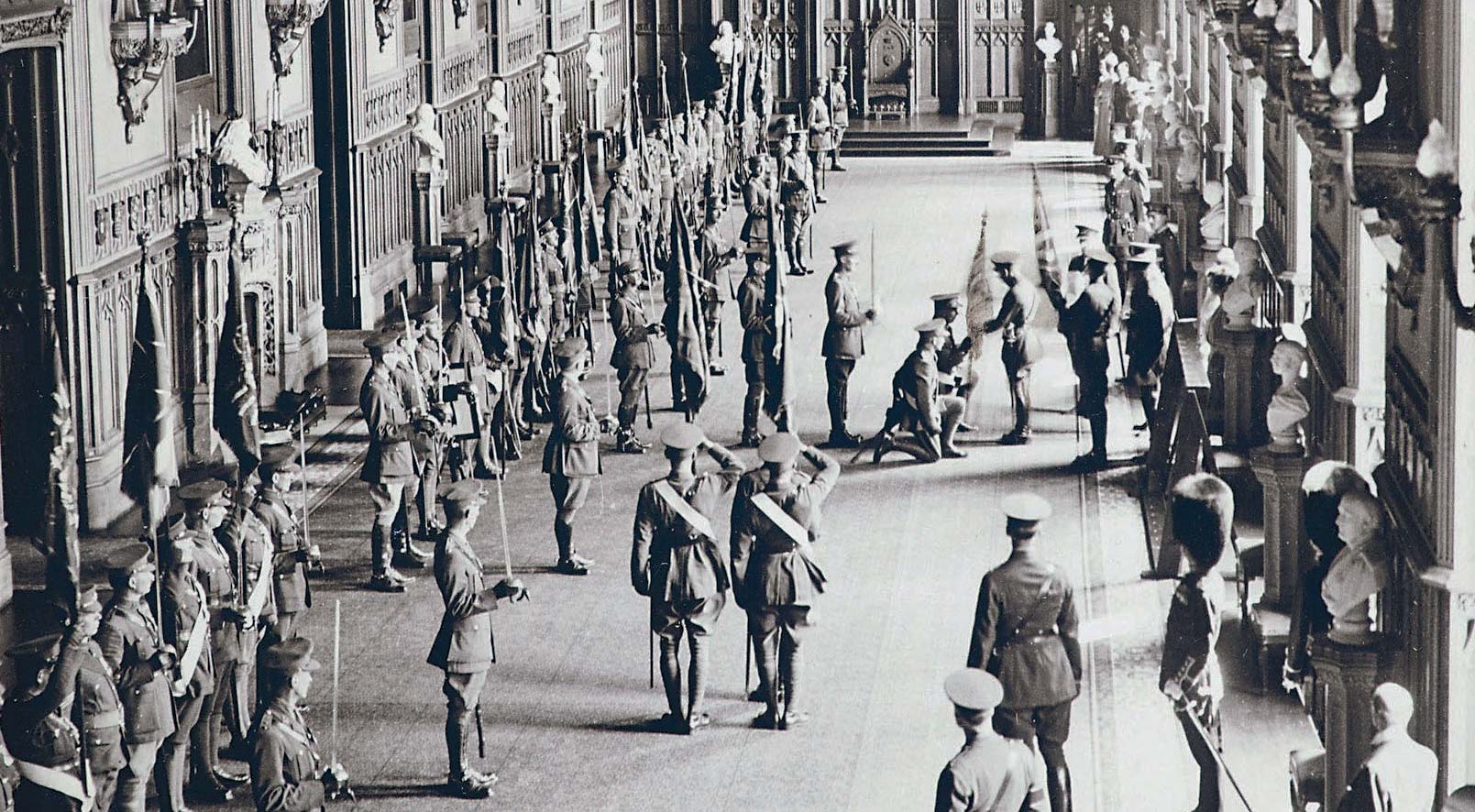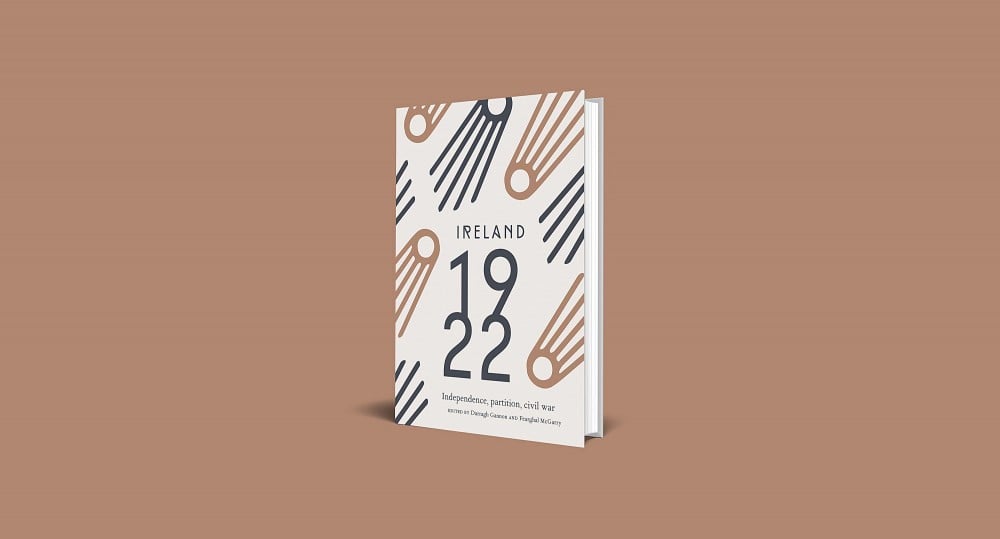12 June 1922: George V Receives the Colours of Disbanded Irish Regiments
Conflicting Identities: Monarchy, Empire and Sovereignty
by Heather Jones
‘The ceremony was one of the most touching that I ever beheld’, recalled John Fortescue, the librarian at Windsor Castle, describing the moment on 12 June 1922 when King George V received back the Colours of Irish regiments that were being disbanded following the establishment of the Irish Free State; ‘The King read a message of farewell to each of the regiments and quitted the hall, leaving most of the officers and non-commissioned officers in tears’.¹ Men, who had been through the trenches of the First World War, wept. Colours were bestowed by the king to the regiments of his army to symbolise the British monarchy that their soldiers bled and died for on the battlefield. For Great War veterans, returning them crystallised that their regiment was no more; even that its recent suffering in the theatres of the conflict had come to nought.
If Britain—and the men gathered at Windsor that day—had won the Great War, handing back the Colours embodied their Irish defeat. The ceremony was a powerful performance of monarchical retreat from the new Irish Free State: military service for the Crown was ending in these counties; the British army, engaged in a post-war cost-cutting exercise, saw these regiments as redundant. To soften the blow, the monarch had offered to care for their Colours in perpetuity. If George V remained the titular head of state, this ceremony highlighted that it was very much going to be a hollowed-out role. It marked the start of modern Irish military independence as clearly as those events that took place in Dublin as the British army handed over its former barracks and a new Irish army was founded. Men rarely wept in public in Britain and Ireland in this period. The emotion of those at the ceremony in Windsor suggests the profound upset that Irish monarchists felt at the Free State settlement. For Northern Irish unionists, the British monarchy was a central part of their identity and remained so. For their peers in the Free State a process of slow letting go of this deepseated part of their culture now began.
Ireland had a long history of anti-monarchism. Its origins were closely linked to the traditional anti-Catholicism of the British monarchy, and it was a feature of folk music about peasant grievance and of the 1798 rebellion and its commemoration, particularly the centenary in 1898. Upon coming to the throne in 1910, however, King George V had reached out to Roman Catholics, dropping the anti-Catholic part of the Coronation oath and, during his 1911 visit to Ireland, visiting the National Seminary at Maynooth and meeting the Catholic Primate. Monarchist sentiment crossed the traditional sectarian divide; the rise of literacy, photography and access to newspapers resulted in human interest stories about the personal lives of royalty that attracted readers from all backgrounds. Although cultural loyalism was a visible feature of unionism, Irish Roman Catholics—in all parts of Ireland—were not all entirely indifferent to the monarchy by 1914.
The Home Rule party tread a fine line between opposing the monarchy and making an accommodation with it: it opposed the 1901 Civil List financial settlement for royals, but some of the party’s support came from Catholic nationalists who favoured greater local Irish governance within the empire and monarchical system. The party’s rapprochement with monarchism was clear by 1914. King George V’s intervention in the Home Rule crisis, calling the Buckingham Palace conference in July 1914 to bring together John Redmond, leader of the Irish Parliamentary Party, and Edward Carson, leader of Irish unionism, was well-received as a peace-making gesture, and as a sign that the monarchy was newly inventing itself as a neutral arbiter on Ireland. The fact that the king signed the third Home Rule Bill that September, despite significant pressure from unionists who petitioned him to refuse it royal assent and trigger a constitutional crisis instead, was also appreciated. The outbreak of the First World War saw this rapprochement deepen.
This context helps to explain the remarkable radicalism of Irish republicanism’s hostility to the British monarchy in the Irish revolution. The Irish Republican Brotherhood and Fenian movement had a long culture of opposing the British monarchy in Ireland. But through the Easter Rising and its aftermath, they successfully marketed this to the public mainstream. Radical anti-monarchism became a central part of their message, as a way of undermining the Home Rule position of wartime rapprochements with the monarchy and unionism, and as a way of breaking with Britishness. This set the IRB and the Fenians on a particular crash course with Ulster unionism, for whom monarchism was a revered core value, now sacralised with the blood of the First World War dead. It was also easy to utilise a grievance with an existing folk history—anti-monarchism—to increase support for advanced separatism. Doing so avoided more complex discussions about what precise type of future state an independent Ireland would be. Republicanism was a rarity in this period; America and France were the main models, and their versions of republican statehood were very different. The Proclamation read by Patrick Pearse outside the GPO in 1916, with its assertion that the people of Ireland were ‘sovereign’ in their own land, switched the locus of power from a living royal sovereign to the population—as befitted a republican understanding of statehood. This was a radical act in 1916 in a Europe still dominated by monarchical states. For Irish republicanism, anti-monarchism was also powerfully egalitarian, implying a state in which all citizens were in a horizontal bond with each other, without a vertical loyalty to a royal hierarchy.
Yet for all the mobilisation around anti-monarchism, George
V’s pre-war image as a well-disposed arbiter remained. It
was most powerfully visible in his speech to open the Northern
Irish devolved parliament in June 1921, when he appealed for a
peaceful settlement in Ireland. Such a significant royal
intervention pushed hawks on the British side to accept a truce
and negotiations; it also undermined any potential protest from
loyalists
reluctant to oppose the king’s will.
By 1922, however, the question of the relationship between monarchy and sovereignty would culminate in triggering Irish civil war. The Irish delegation to the Treaty talks was fully aware of the implications of including in the Anglo-Irish Treaty an ‘oath of allegiance’ to the British monarch for TDs in Dáil Éireann.² An oath acknowledged the nation as embodied in a living monarch. It was a tortuous focus of the negotiations. The Irish negotiators managed to get the wording of the oath watered down into an oath of ‘fidelity’ to the king, but the British monarch remained head of state of the new Irish Free State. The British for their part were adamant that the oath had to be part of the settlement. Every dominion parliament had an oath of allegiance to the king. Moreover, since 1917, the empire dominions were being reformulated as independent states, joined to Britain solely through its monarchy and its ties with their constitutions, and no longer also through Westminster and its civil service as had been the case before the outbreak of the First World War. For Prime Minister David Lloyd George, the oath of allegiance to the king was the principle ‘upon which the whole fabric of the empire and every constitution within it are based’.³ It was impossible for these reasons for Britain to conceptualise a republic as part of its empire in this period, although the Irish delegation suggested this as one possible compromise. This culture clash over monarchism profoundly undermined the Treaty.
Monarchism and anti-monarchism ultimately played a pivotal—and still understudied—role in mobilising and polarising Ireland during the Irish revolution. The emotional power of the cleavage over monarchism to trigger violence should not be underestimated. Its terminology—Crown forces, King’s shilling, traitor, loyalist—intensified animosities and mobilised unionist against republican. In the debates around the ‘oath of allegiance’ it was powerful enough to help trigger an internecine civil war among nationalists. It was also one of the historic fault lines of the era. As monarchies fell across Europe in the wake of the Great War, Irish republicanism looked less opportunistic in its mobilisation of vitriolic antimonarchism and more prescient. Embracing such very radical forms of hostile anti-monarchist discourse, however, doomed the Irish Free State settlement and helped ossify the division with unionism, creating a ‘long’ 1922 that lasted until Éamon de Valera’s government dismantled the final elements of Treaty monarchic structures, and beyond.
Extracted from Ireland 1922 edited by Darragh Gannon and Fearghal McGarry and published by the Royal Irish Academy with support from the Department of Tourism, Culture, Arts, Gaeltacht, Sport and Media under the Decade of Centenaries 2012-2023 programme. Click here to view more articles in this series, or click the image below to visit the RIA website for more information.






















